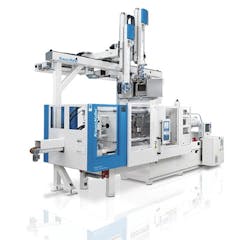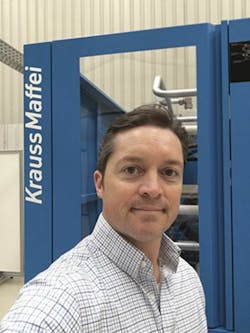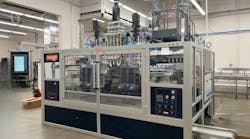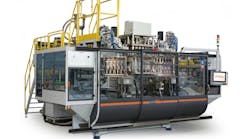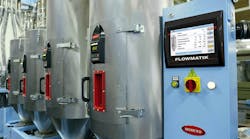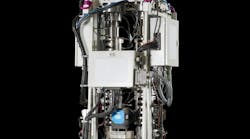Machinery suppliers announced enhancements to a method for making structural composite parts and the application of valve-gate control technology to family molds. They showed off their innovations at the Molding 2017 conference and exhibition, sponsored by Plastics Technology magazine and Gardner Business Media, and held last month in Charlotte, N.C.
KRAUSSMAFFEI OPTIMIZES FIBERFORM
KraussMaffei optimized equipment and automation used with its FiberForm process for shorter cycle times and space savings. The FiberForm process produces structural composite parts in one shot by combining coining of thermoplastic composite sheet with injection molding to produce a lightweight, high-strength, lower-cost replacement for metal parts in automotive and other applications, said Jason Holbrook, regional sales manager, injection molding division.
A fabric composed of glass, carbon or aramid fiber in a thermoplastic matrix is heated, shaped in the injection mold, and then overmolded or back-injection molded in specific areas, usually with a compatible or similar reinforced polymer. KraussMaffei's MX, GX or CX two-platen servo-hydraulic presses run the FiberForm process.
KraussMaffei has updated the design and capability of the infrared oven for faster preheating and enhanced monitoring and control. The oven, used to heat the thermoplastic composite sheet, is now more compact and positioned atop the stationary half of the mold. Previously, the oven was beside the injection press, but within the molding cell. The new design shortens sheet transfer times.
KraussMaffei developed new programming for the infrared emitters that is fully integrated into the MC6 injection molding machine control system. New programming features include a preheating program that shortens the start-up process. In addition, a control algorithm developed in-house provides uniform heating of individual zones.
The heater controller prevents the set temperature from being exceeded, which prevents degradation of the composite sheet. It monitors each heating zone in the oven and tracks temperature changes. This data, as well as heating time and actual temperatures, are displayed and stored on the MC6 controller.
Previously, the automation used within the protective housing of a FiberForm molding cell was a six-axis robot; the new configuration features a linear robot with two three-axis servo robots mounted onto the same beam, or X-axis. Each LRX-250 TwinZ linear robot has a 55-pound payload and is controlled by the MC6 machine control for ease of programming, operation and data acquisition.
The machine control monitors all mechanically linked axes of the robot, and features an intelligent control and collision prevention program. The LRX robot also has a new digital vacuum control that reduces the robots' compressed air usage by as much as 90 percent. The LRX robot monitors itself for air leakage.
Operating two robots on a single beam shrinks the overall size of the molding cell 5 percent, while the use of the two robots reduces cycle times. The robot closer to the moving mold half picks up an unheated sheet from a magazine, and hands it off to the second robot, and then reaches into an open mold and removes a finished part, which is weighed before being placed on a conveyor. The second robot places the unheated composite sheet into the oven, then removes a heated sheet and places it into the mold. The grippers and end-of-arm-tooling are optimized to place organic sheet heated to 536 degrees Fahrenheit into the mold without the sheet fluttering, Holbrook said. KraussMaffei integrated all handling processes into a standard machine housing to reduce the cell's footprint.
KraussMaffei also incorporated a QR code printer into a FiberForm molding cell to demonstrate its Industry 4.0 approach. A Krauss-Maffei CX 300-1000 FiberForm injection molding machine produced a prototype automotive part. The 6.7-gram part, produced from glass-fiber reinforced polyamide 6 sheet and back-molded with glass-filled PA 6, was produced in a single-cavity mold in a 39-second cycle. A QR code containing process data was printed and affixed to the part after it was demolded and placed on a conveyor. A molder or user could access the production data about that component through a mobile device.
HRSFLOW FOCUSES ON FAMILY MOLDS WITH VALVE-GATING TECHNOLOGY
HRSflow has expanded the capabilities of its FLEXflow servo-driven valve-gate system. Designed to control melt flow through the hot-runner nozzles in a multicavity or multidrop tool, the system now can be used with family molds featuring cavities with vastly different shot weights, said President John Blundy.
FLEXflow's servo-motor control, initially developed to improve melt flow in sequential or cascade molding, is being applied to molds having different cavity volumes. With FLEXflow, the stroke, position, acceleration and velocity of each valve pin can be adjusted, which in turn controls melt pressure and melt flow. Mold fill and packing are controlled by adjusting the movements of the valve pin. The servo-motor does not require pipes and connections for oil or water.
With FLEXflow, valve pin movement is accurate to within 0.01mm. The system allows molders to control up to eight movements of the pin over a stroke length of up to 18mm. The precise, programmable and repeatable pin movements ensure that all cavities are filled within the same period of time despite different part volumes, Blundy said.
HRSFlow designed a valve-pin controller available in configurations for four, six, eight, 10, 12 or 16 zones. Accurate profiling of the pin movement smooths out hydrostatic pressure fluctuations, allows for clamping forces to be reduced as much as 20 percent, reduces part warping through melt flow balancing and can trim part weight by 5 percent, Blundy said. Users can also accurately replicate short-shot conditions to identify potential design or flow issues, such as hesitation lines or weld marks.
At Molding 2017, HRSFlow displayed automotive front grille parts produced from PC/ABS in one shot in a family mold with 10 gating points. The molded parts ranged from 7 grams to 140 grams.
FLEXFlow can be installed on a mold plate, on a manifold or in a lateral configuration. Plate-mounted FLEXFlow nozzles are offered with a closing force range of 529 to 2,866 pounds, have a pin velocity that can range from 0.05 to 50mm per second, and have a maximum stroke of 18mm.
Manifold-mounted, valve-gated nozzles have closing forces ranging from 165 to 661 pounds, and pin velocities ranging from 0.05 to 40mm per second, with a maximum stroke of 12mm.
Mikell Knights, senior staff reporter
For more information
HRSflow
Byron Center, Mich., 616-228-6900, www.hrsflow.com
KraussMaffei Group USA
Florence, Ky., 859-283-0200, www.kraussmaffeigroup.com
